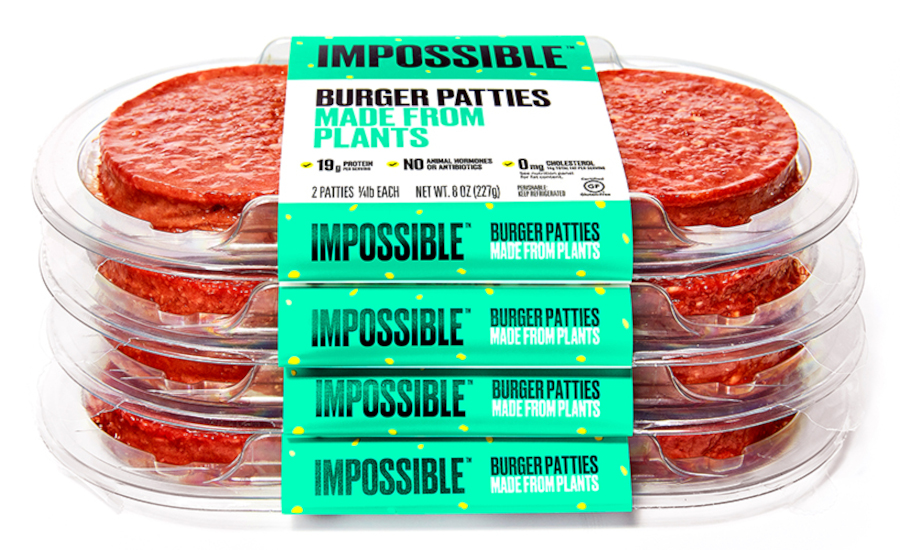Sponsored by

For consumers of meat, poultry, and seafood products, convenience still sells, and concerns about sustainability remain strong. Processors are addressing these needs while paying close attention to quality, line efficiency, and labor requirements, which increasingly are being addressed by automation.
Convenience rules worldwide
Winners in recent packaging competitions show the interest in convenience continues unabated. In the annual Flexible Packaging Achievement Awards competition sponsored by the Flexible Packaging Association (FPA), Crunch Pak’s Toy Story Lunch Kitz received the Highest Achievement Award, a Gold – Technical Innovation. The 4-ounce snack tray with individual compartments contains sliced apples, an artisan cracker, string cheese, and Italian salami. The foods are fresh and healthy, including the salami, which is without nitrates, nitrites, or artificial ingredients.
The zeal for convenience is not limited to North America. The Youfoodz Meal Kit, an Australian winner of a WorldStar from the World Packaging Organisation, holds ingredients for an easy-to-cook meal. When ready to use, releasing a notch in the handle opens the briefcase-style carton, which refolds into a tent card that displays easy-to-follow cooking instructions. This package also scores sustainability points because its two-piece construction represents a 30 percent source reduction compared to a single-piece carry case design of the same size.
A WorldStar winner from Japan, Ajinomoto’s “Steam Me” microwave pressure-cooking pouch, is designed to cook raw meat in the microwave. A port releases steam generated during cooking to ensure the pouch doesn’t fail. This design also scores sustainability points because it doesn’t need primary or secondary cartons. The retail-ready distribution case opens with one-touch and is ready to be stocked on store shelves.
Consumers favor sustainable packaging
Sustainability takes many forms – source reduction, recycled content, adoption of recyclable materials, and replacement of non-renewable materials with renewable. Source-reduced packaging reduces the amount of material used through a redesign or conversion from a rigid format to a flexible one. One source-reduction option being explored is trayless ground meat packaging, which replaces traditional ground meet packaging with a flow-wrapped, all-film design. Eliminating the tray also reduces packaging costs.
Another source-reduced package, a reclosable zipper pack for Smithfield Prime Fresh Delicatessen sliced lunchmeat, resembles packaging used at the deli counter and evokes freshness. The Silver Award winner in FPA’s competition was recognized for expanding the use of flexible packaging and features a surface-printed, high-barrier, coextruded dual forming web instead of the typical laminated film. Benefits include improved shelf life, less product waste, and a source reduction of 31 percent compared with the tub/lid format often specified for lunchmeat.
Recycled-content packaging also is receiving attention. A proprietary vacuum skin package for Impossible Burger, from Impossible Foods, consists of a clear recycled polyethylene terephthalate (PET) tray with easy-open PE film. It was recognized by the Institute of Packaging Professionals with an AmeriStar in the Food (Refrigerated) category.


Switching from non-recyclable to recyclable films is another sustainability tactic. Recyclable films are already available in Europe. One WorldStar winner in the Packaging and Components category – a thermoformable, monomaterial film – has been adopted in Austria by Hütthaler for meat and sausage products sold in Hofer supermarkets. It not only runs well on packaging equipment but also offers excellent barrier properties and the potential for extended shelf life.
WorldStar winners also show a shift away from plastic packaging to renewable materials at all levels of the supply chain. A number of cold-chain shippers have converted from expanded polystyrene (EPS) to all-paper-based materials. The designs typically combine easy-opening, product protection, and a consumer-pleasing unboxing experience.
The Lobster Protector, a winner of a WorldStar in the Food category, is 100% plastic-free, flat-packed, and made of materials that are either recyclable, compostable, or biodegradable. Price-competitive against expanded polystyrene (EPS), the shipper, which is marketed in Australia and New Zealand, offers superior thermal performance, maintains product temperatures within the required 7 C–12 C range for 36 or more hours, minimizes carbon dioxide buildup, and controls humidity levels and moisture during transit. Lobsters, which are shipped live, reportedly arrive at their destination in a healthier state. Lower mortality rates and less moisture loss maximize commercial value.
No- or reduced-plastic structures also have been developed for primary packaging. Another WorldStar winner replaces traditional foam and crystallized PET trays with a recyclable paperboard structure. Compatible with modified atmosphere and vacuum skin packaging, the trays offer a continuous sealing flange and easily separated film liner. The resulting package, used by Liffey Meats for dry-aged Angus steaks sold in Ireland, cuts plastic consumption up to 90 percent and offers the potential for up to 28 days of shelf life. An associated machine erects, lines, fills, and seals the paperboard tray from a precut, flat paperboard blank.

Automating quality control
With product quality always a top-of-mind concern, many firms are automating inspection. Longhini Sausage Co., a maker of Italian sausages and other specialty meat products, for example, has installed two metal detectors. “We decided to automate inspection back in 2015 after seeing other companies experience metal contamination issues that were completely preventable,” recalls David Kemp, CEO of Longhini.
“Our application is difficult for most metal detectors,” explains Rich Longhini, president of the maker of specialty meat products. “Meat products have natural variations in temperature and moisture, plus our wide range of case sizes presents a variation in product density. Products with variable characteristics are hard to accurately inspect. To overcome these challenges, we had to find an unusually advanced metal detector.”
The first unit, purchased 2015, is a semi-automated, standalone system on wheels that inspects cased products offline. To increase throughput, a second unit on wheels was purchased in 2019, but this one is moved from line to line to fully automate inspection. The inline system inspects thermoformed packages ranging from six ounces to one pound and tray packs weighing between five and 10 pounds. The offline system now exclusively inspects cases weighing from five to 40 pounds, filled with either bulk sausages or tray packs not already inspected on the inline system.
The machines use multi-simultaneous frequencies to create a reference point and therefore can better differentiate between the presence of metal vs. natural product variations than a traditional single-frequency system. This heightened sensitivity virtually eliminates false rejects.
“One of our favorite features is the product clustering capability, which allows us to run many similar products under the exact same setting,” Longhini says. “We can almost always lump new products together under existing product settings. We also like the auto-setup routine. With it, our operators can easily add totally new products or recalibrate in less than five minutes. We test them a few times a day, which is why we know they’re consistently sensitive across our different products and packages.”
Boosting line efficiency
For several years now, many plants have been automating packaging operations to increase efficiency and reduce labor requirements. The pandemic has accelerated that trend. “Automation is high on the agenda in many sectors, following the ravaging of workforces by the virus, and the subsequent need to enforce social distancing in the workplace,” according to Coming through COVID-19, a white paper published in June 2021 by PMMI, the Association for Packaging and Processing Technologies.
Nearly one-third (31 percent) of respondents said they are currently using and will continue to use automated machinery as a substitute for appropriately qualified manpower, and 30% reported they have plans to introduce automation for that reason in 2021. One respondent noted, “COVID-19 has driven a tremendous urgency to automate repetitive-motion tasks across manufacturing. Skilled labor will continue to be required but [the] availability of repetitive-motion labor will continue to be challenging and automation will be required to address the risk.”
Some of the tools driving the adoption of automation include the Industrial Internet of Things (IIoT) and integration of more machines with data acquisition capabilities. Other drivers include the expansion of robotics in secondary packaging and palletizing, remote access, and the availability of artificial intelligence and predictive analysis for maintenance, according to another white paper from PMMI, Automation timeline: The drive toward 4.0 connectivity in packaging and processing.
Remote support is a particularly hot topic. “Remote support has been given a boost by the pandemic, and its time and cost benefits mean it is here to stay,” explains the Coming through COVID-19 paper. In short, CPG companies want higher levels of support, diagnostics, service, and training (with interactive simulations) delivered remotely. In fact, 48 percent of the CPG companies surveyed are currently using remote access and plan to continue using it and 15 percent plan to implement it in 2021. Another 7 percent have adopted the technology for use during the pandemic.
To help companies maximize benefits from remote access, OMAC - The Organization for Machine Automation and Control, published a free, vendor-neutral guide, the Practical Guide for Remote Access to Plant Equipment. The product of a workgroup representing manufacturers, machine builders, system integrators, and technology providers, it defines best practices for remote access. A successor workgroup has begun preparing an addendum focused solely on cybersecurity and areas of remote access that require protection.
“While defensive technologies will evolve and improve over time, this workgroup will review the mechanisms used today for remote access and identify areas for improvements,” says OMAC board member Spencer Cramer, CEO of ei3, a provider of secure remote access technology and leader of the workgroup. Discussion centers on remote connection methods such as direct VPN, converged network, cell modem access, Black Box, external managed secure network, and technician access, as well as configurations to provide protection from cyberattacks. The addendum is scheduled to be published in January 2022.







